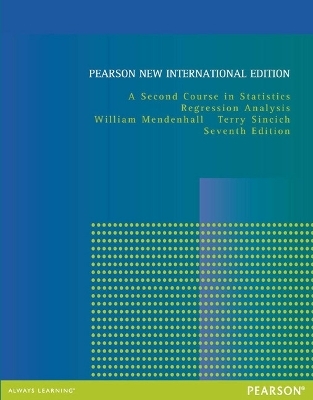
Second Course in Statistics, A: Regression Analysis
Pearson Education Limited (Verlag)
978-1-292-04290-9 (ISBN)
Mendenhall/Sincich’s A Second Course in Statistics is the perfect book for courses that build on the knowledge students gain in AP Statistics, or the freshman Introductory Statistics course.
A Second Course in Statistics: Regression Analysis, 7th Edition, focuses on building linear statistical models and developing skills for implementing regression analysis in real situations. This text offers applications for engineering, sociology, psychology, science, and business. The authors use real data and scenarios extracted from news articles, journals, and actual consulting problems to show how to apply the concepts. In addition, seven case studies, now located throughout the text after applicable chapters, invite students to focus on specific problems, and are suitable for class discussion.
1. A Review of Basic Concepts (Optional)
1.1 Statistics and Data
1.2 Populations, Samples, and Random Sampling
1.3 Describing Qualitative Data
1.4 Describing Quantitative Data Graphically
1.5 Describing Quantitative Data Numerically
1.6 The Normal Probability Distribution
1.7 Sampling Distributions and the Central Limit Theorem
1.8 Estimating a Population Mean
1.9 Testing a Hypothesis About a Population Mean
1.10 Inferences About the Difference Between Two Population Means
1.11 Comparing Two Population Variances
2. Introduction to Regression Analysis
2.1 Modeling a Response
2.2 Overview of Regression Analysis
2.3 Regression Applications
2.4 Collecting the Data for Regression
3. Simple Linear Regression
3.1 Introduction
3.2 The Straight-Line Probabilistic Model
3.3 Fitting the Model: The Method of Least Squares
3.4 Model Assumptions
3.5 An Estimator of s2
3.6 Assessing the Utility of the Model: Making Inferences About the Slope ß1
3.7 The Coefficient of Correlation
3.8 The Coefficient of Determination
3.9 Using the Model for Estimation and Prediction
3.10 A Complete Example
3.11 Regression Through the Origin (Optional)
Case Study 1: Legal Advertising--Does It Pay?
4. Multiple Regression Models
4.1 General Form of a Multiple Regression Model
4.2 Model Assumptions
4.3 A First-Order Model with Quantitative Predictors
4.4 Fitting the Model: The Method of Least Squares
4.5 Estimation of s2, the Variance of e
4.6 Testing the Utility of a Model: The Analysis of Variance F-Test
4.7 Inferences About the Individual ß Parameters
4.8 Multiple Coefficients of Determination: R2 and R2adj
4.9 Using the Model for Estimation and Prediction
4.10 An Interaction Model with Quantitative Predictors
4.11 A Quadratic (Second-Order) Model with a Quantitative Predictor
4.12 More Complex Multiple Regression Models (Optional)
4.13 A Test for Comparing Nested Models
4.14 A Complete Example
Case Study 2: Modeling the Sale Prices of Residential Properties in Four Neighborhoods
5. Principles of Model Building
5.1 Introduction: Why Model Building is Important
5.2 The Two Types of Independent Variables: Quantitative and Qualitative
5.3 Models with a Single Quantitative Independent Variable
5.4 First-Order Models with Two or More Quantitative Independent Variables
5.5 Second-Order Models with Two or More Quantitative Independent Variables
5.6 Coding Quantitative Independent Variables (Optional)
5.7 Models with One Qualitative Independent Variable
5.8 Models with Two Qualitative Independent Variables
5.9 Models with Three or More Qualitative Independent Variables
5.10 Models with Both Quantitative and Qualitative Independent Variables
5.11 External Model Validation
6. Variable Screening Methods
6.1 Introduction: Why Use a Variable-Screening Method?
6.2 Stepwise Regression
6.3 All-Possible-Regressions Selection Procedure
6.4 Caveats
Case Study 3: Deregulation of the Intrastate Trucking Industry
7. Some Regression Pitfalls
7.1 Introduction
7.2 Observational Data Versus Designed Experiments
7.3 Parameter Estimability and Interpretation
7.4 Multicollinearity
7.5 Extrapolation: Predicting Outside the Experimental Region
7.6 Variable Transformations
8. Residual Analysis
8.1 Introduction
8.2 Plotting Residuals
8.3 Detecting Lack of Fit
8.4 Detecting Unequal Variances
8.5 Checking the Normality Assumption
8.6 Detecting Out
| Erscheint lt. Verlag | 1.11.2013 |
|---|---|
| Verlagsort | Harlow |
| Sprache | englisch |
| Maße | 216 x 276 mm |
| Gewicht | 1660 g |
| Themenwelt | Mathematik / Informatik ► Mathematik ► Analysis |
| Mathematik / Informatik ► Mathematik ► Statistik | |
| ISBN-10 | 1-292-04290-7 / 1292042907 |
| ISBN-13 | 978-1-292-04290-9 / 9781292042909 |
| Zustand | Neuware |
| Informationen gemäß Produktsicherheitsverordnung (GPSR) | |
| Haben Sie eine Frage zum Produkt? |
aus dem Bereich


